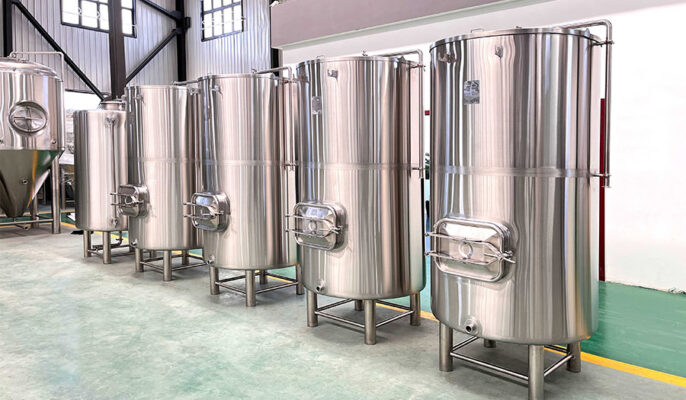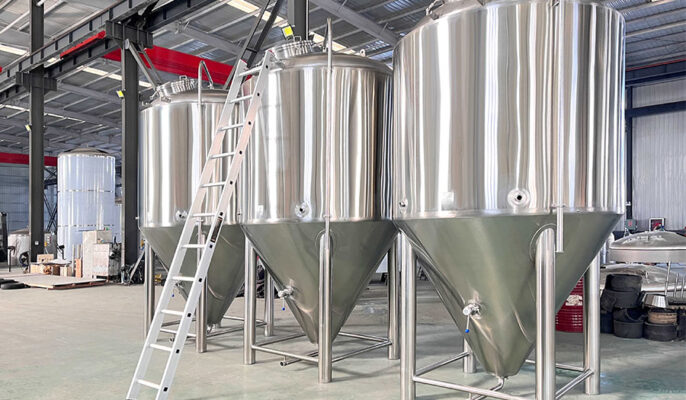Brewing tanks come in many shapes and sizes, and the type of beer you want to brew will determine which tank will help you best. With local breweries popping up across the country, there are more opportunities for you to try this ancient craft and create your brewing specialty. Some people have mastered the craft enough to pursue it , and also need some extra equipment at home so they can set up their own personal “local brewery.”
Mash tun
The mash tun is the vessel used in home brewing to create wort: a mixture of malted grains and water. The mash tun not only mixes the ingredients into a mixture with a porridge-like consistency, but it also regulates the temperature of the mixture. This is important because if the temperature is too cold, your mixture will be runny. If the temperature is too high, the wort will have difficulty interacting with the yeast later in the process.
Lauter Tun
Premium filter barrels have rotating rake arms with a central drive. Depending on the size of the filter bucket, there can be between two and six rake arms. The cutting blades are suspended from these arms. The blade is usually wavy and has a plow-like base. Each blade has its path around the drum, and the entire rake assembly can be raised and lowered. Attached to each arm is a flap that can be raised and lowered to push spent grain out of the barrel. The brewery, or better yet an automated system, can raise and lower the rake arms based on the turbidity (turbidity) of the runoff and the tightness of the grain bed (measured by the pressure difference between the top and bottom of the grain bed).

kettle
The kettle is used to boil the wort. The simplest version is fired by a burner set below it. The disadvantage of these is that it will often scorch the wort where the flame contacts the kettle. Most breweries have switched to steam kettles, which are steam-jacketed to boil the wort. Steam comes from an external boiler. A more sophisticated version of the kettle is the calandria type, which is an external pressure boiler into which the wort is pumped before being pressurized in the kettle. Calandria reduces boiling times by about 30%; yet, they are difficult to clean.
Fermenter
Fermenters are used in almost all fermentation processes. A fermenter is a closed, sterile container that provides optimal growth conditions for the reproduction of microorganisms. Fermentation tanks are an important part of the beer production process. Its unique design allows easy harvesting of yeast and efficient carbon dioxide removal, ensuring constant contact between yeast and wort, promoting fast and complete fermentation, and is easy to clean and sterilize. Conical fermenters are a common design used by many breweries and are a key component in producing high-quality beer.
Fermenters usually have the following basic components:
- Pressure relief valve
- On-site glass
- Sampling cock
Bright tank
A bright beer tank is a brewing equipment that matures, clarifies, and carbonates beer after fermentation. In some cases, draft beer cans double as beer bar serving containers, eliminating the need for kegs. The perfect amount of carbonation can turn a decent beer into a fantastic beer. For this reason, you need to control the carbonation level of your beer if you want to produce the best possible end product. Brite tanks are an important part of the brewing process, used to create the right amount of carbonation and keep it carbonated for a long time. Beer cans will be one of the last places your beer spends before bottling or drinking.
Light beer cans have the following basic components:
- Spray ball
- Carbon fossils
- Sampling cock
- Pressure gauge
- On-site glass
- There is a valve at the bottom
Horizontal sake tank
For a proper beer, you need a specialized tank to help develop the flavor in the right way. This is where horizontal beer cans come in handy. The bottom of the tank has a large surface area, creating the right conditions for brewing beer . Because it’s horizontal, there’s also more surface area available on top of the liquid inside the beer can. Both of these factors contribute to brewing the beer you want.
Cold liquid tank (CLT)
A CLT is a short-term cold liquid tank used to store cold water in beer containers. The CLT is used to cool the wort from the plate heat exchanger to the fermenter. Of course, the cold liquid tank can also receive cold water from the plate heat exchanger. The tank is usually stainless steel and is placed near the brewery equipment, near the heat exchanger.
The cold liquid tank is welded with a cooling jacket, which means it has an inner shell and an outer shell, and the inner shell and the outer shell are filled with insulating material. Between this housing is a coil of tubing that allows the glycol from your cooling system to pass through it, allowing you to cool the water in the tank to the desired temperature.

Hot water tank
A hot water tank is a large insulated container used to store and heat water to a specific temperature. These tanks are usually made of stainless steel and are available in a variety of sizes, depending on the needs of the brewery. Water tanks are usually equipped with heating elements and temperature controllers to ensure that the water is heated to the required temperature and maintained at that temperature for the required time.
HLT heating capacity:
- Steam heating
- Electric heating
- Direct heating
- External steam heat exchange
Storage tank
Tanks used for storage are usually located in cooler sections and are often not insulated. Manholes are located on the top of the storage vessel, or sometimes on the side (side manholes) if the tank has an ASME (American Society of Mechanical Engineers) pressure rating of 30-psi. There is a drain hole at the bottom to ease the discharge of contents.
Basic components of storage tanks:
- Pressure relief valve
- Construction site glass
- Sample test cock
- Side frame arms for yeast cake positioning
FAQ
Q:What does a brewhouse consist of?
A:The brewhouse is the name of the room used for beer brewing. The brewhouse is composed of a mash tun, filter tun, boiling tun, and whirlpool tun. There are different combinations of these four tanks for different brewing processes and capacities. Commonly used are combinations of 2 vessels, 3 vessels, and 4 vessels. Also, depending on the brewing process, the brewhouse will also be equipped with cold water tanks, ice water tanks, or hot liquid tanks.
Q: Is opening a brewery right for you?
A: Brewing is a challenging around-the-clock job. Yet, if you commit to starting a brewery, it could be one of the most rewarding things you ever do! If you enjoy homebrewing or are preparing to enter the beer industry, it is crucial to understand the funding and space you will need. Many breweries end up wishing they had a bigger infrastructure to begin with, and, like all commercial enterprises, yours may cost more and take longer than you expect.
Q: Why do I need a conical fermenter?
A: There are many good reasons to use a conical fermenter for home brewing. They are very convenient and easy to use. Conical fermenters allow you to use the bottom outlet to remove dregs and yeast from your beer before and during fermentation. This removes the solids that cause beer to have off-flavors.
Q:What is a bright tank for?
A:A bright tank is a tank used to clarify beer and beer carbonation, and is also called a “brite tank”. In most breweries, the fermented beer will leave the fermentor, be filtered, and transferred to the bright tank for further clarification and maturation of the beer. If you want to force carbonation of beer, you can also do it in a bright tank. After carbonation, the beer can be barreled or bottled directly. Because the bright tank is the last stop before packaging, so you need to pay extra attention at this stage.




